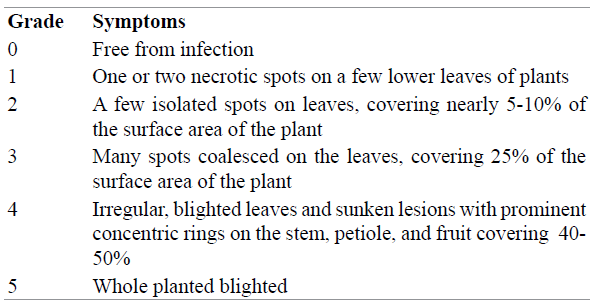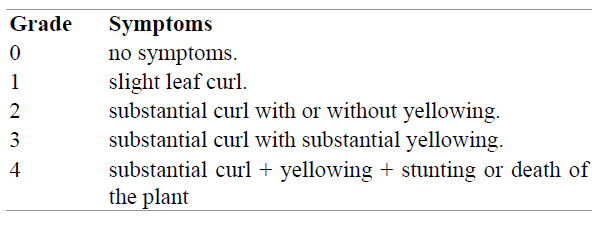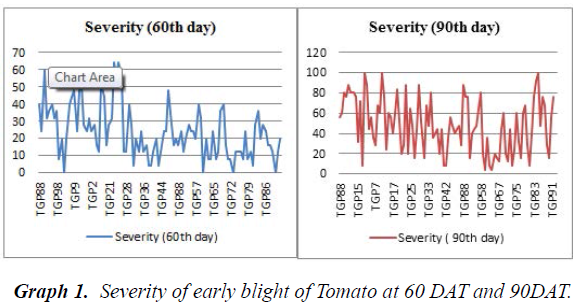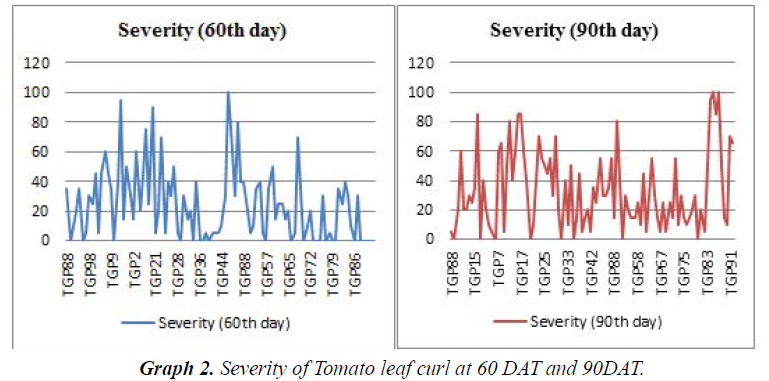Research Article - Journal of Agricultural Science and Botany (2021) Volume 5, Issue 11
Screening of tomato genotypes against early blight (Alternaria solani) and tomato yellow leaf curl virus in natural conditions.
Harish J1, Chetan S2, Chetan P3, Bhargavi1, Sanjay HB4, Naveen M5, Srinivas5*
1Department of Plant Pathology, RLBCAU, Jhansi, Uttar Pradesh
2Department of Vegetable Science, RLBCAU, Jhansi, Uttar Pradesh
3Department of Plant Pathology, COA, MPKV, Pune, Maharashtra
4Department of genetics & Plant breeding, RLBCAU, Jhansi, Uttar Pradesh
5Department of Entomology, RLBCAU, Jhansi, Uttar Pradesh
- *Corresponding Author:
- Harish J
Department of Plant Pathology RLBCAU Jhansi Uttar Pradesh
E-mail: harishbpl5021@gmail.com
Accepted Date: November 18, 2021
Citation: Harish J, Chetan S, Chetan P, Bhargavi, Sanjay HB, et al. Screening of tomato genotypes against early blight (Alternaria solani) and tomato yellow leaf curl virus in natural conditions.. J Agric Sci Bot. 2021;5(11): 078.
Abstract
The tomato (Solanum lycopersicum L.) is one of the most widely consumed vegetables in the world. Tomatoes are adversely affected by a multitude of infections caused by fungi, bacteria, viruses, nematodes, and abiotic factors. Early blight disease caused by Alternaria solani and Tomato leaf curl virus have been a serious problem in tomato growing areas, particularly in humid tropical, subtropical, and temperate regions of the world. 97 genotypes were screened for 2 diseases at 60 DAT. 31 showed high resistance, 32 genotypes were showed resistant, 17 showed moderately resistant no genotypes found highly resistant, 16 showed resistant reaction, 12 genotypes were found moderately resistant for the Early blight at 90 DAT. At 60 DAT, 38 genotypes showed highly resistance, 16 showed resistance reaction, 17 were moderately resistance. During 90 DAT, 17 genotypes showed highly resistance reaction, 27 were resistant, 13 were moderately resistant against leaf curl. The genotypes showed resistant reaction were TGP 60, TGP 27, TGP31, TGP77, TGP63 and TGP65 to early blight reaction. TGP96, TGP8, TGP36, TGP80, TGP88, TGP13 and TGP 21 genotypes were highly resistant reaction against leaf curl virus.
Keywords
Keywords: Incidence, resistant, susceptible, severity, screening
Introduction
The tomato (Solanum lycopersicum L.) is one of the most widely consumed vegetables in the world, second only to potatoes. It belongs to the Solanaceae family and is a good source of vitamin A, vitamin C, and minerals. It is grown in almost every country and in many nations around the world. In terms of importance, it is second only to potatoes. According to FAO 2019 estimates, tomato was grown on nearly 50.30 lakh hectares worldwide, with an annual production of 180.76 million tonnes and a productivity of 35.9 t/ha. China is the world's leading tomato producer. Other major tomato producing countries include India, Turkey, the United States, and Egypt. Madhya Pradesh, Karnataka, Uttar Pradesh, Orissa, Andhra Pradesh, Maharashtra, Telangana and Gujrat are the major tomato growing states in India.
Tomatoes are adversely affected by a multitude of infections caused by fungi, bacteria, viruses, nematodes, and abiotic factors. Early blight disease caused by Alternaria solani has been a serious problem in tomato growing areas, particularly in humid tropical, subtropical, and temperate regions of the world. Early blight is caused by an airborne and soil-dwelling organism [1]. High temperatures and extended periods of leaf wetness from dew, rain, and cluttered plantation have been favourable for disease development. Disease symptoms appeared on all aboveground plant parts, particularly its leaves, stems, petioles, flowers, and fruits [2]. The yield loss caused by early blight has been increasing as the disease's prevalence has increased due to changes in environmental conditions. Early blight can result in a 78 percent loss in fruit yield [3,1].
In addition to fungal and/or bacterial diseases, there are pests and viral diseases, the most important and dangerous of which is Tomato yellow leaf curl virus (TYLCV) [4,5]. Tomato leaves curl and turns yellow as an outcome of TYLCV. The virus, which is propagate by the whitefly Bemisia tabaci Gennadius, is classified as a "Geminivirus"[6,7,8]. The symptoms become much more severe as the variety is becoming more susceptible and the edapho-climatic conditions are becoming more difficult. When the virus is transmitted before flowering, harvests are almost totally none. If transmission occurs after flowering, the few flowers that form yield very small fruits, resulting in a 75 % [9]. The first case of tomato leaf cure virus was discovered in the eastern Mediterranean, and it was later reported to be a major problem in the Middle East, African continents, southeast Asia, and southern Europe [10]. It is the tomato leaf cure virus, which is a devastating problem for tomato production in northern India, causing up to 99–100% losses and has become a major impediment for tomato producers.
Materials and methods
Experiment was conducted in Horticultural experimental block, RLBCAU, Jhansi. To screen tomato genotypes against early blight and Leaf curl disease. Nighty seven genotypes of tomato were used in this experiment which was sown in three rows with 2 replications and maintaining planting distance of 60cm between rows and 50cm between plants (Graph 1). Plants were individually evaluated for disease scoring in each genotypes using 0-5 disease scale as given by [11].

In order to assess symptom severity of leaf curl, an observation scale with 5 classes was adopted [12,13].

Percent disease index was calculated by the formula given by
[14,2]

Disease reaction classes for infection based on percent disease severity in tomato given by [15].

Results and discussions
97 genotypes were screened for resistance against early blight and tomato leaf curl in natural conditions. Percentage disease index was calculated based on incidence occurred during 60 days and 90 days. Tomato genotypes showed various reactions. During 60th day, out of 97 genotypes, 31 showed high resistance, 32 genotypes were showed resistant, 17 showed moderately resistant, 11 showed susceptible and 7 showed highly susceptible were shown in (Table 1). Where as in case of 90 days severity in 97 genotypes of tomato, no genotypes found highly resistant, 16 showed resistant reaction, 12 genotypes were found moderately resistant, 24 were found susceptible and 45 genotypes were highly susceptible were shown in (Table 2). The disease incidence was less during vegetative stages. The disease was severely spread after flowering, covered whole leaf, stem, petiole and even on the surface of berry. Target board symptoms were also produced later on coalesced to from blighted appearance. The severity of Alternaria before flowering varies from 0- 64%. But after flowering stage the disease severity varies from 16-100%. The genotypes which showing high resistance during 60 DAT were showing resistance reaction during 90th day. The genotypes showed resistant reaction were TGP 60, TGP 27, TGP31, TGP77, TGP63, and TGP65 to early blight reaction. Sel-35 (TLBRH-6 X Konbilahi) and Sel- 19 (TLBRH-6 X Konbilahi) genotypes were highly resistant, while 7 were resistant, 14 were moderately resistant, 16 were susceptible, and 6 were highly susceptible. The outcome was found to be similar for both years. The disease caused a yield loss ranging from 2.15 percent in highly resistant genotypes to 42.75 per cent in highly susceptible genotypes [16]. Screening genotypes for early blight resistance earlier was carried out by [17,18, 19, 20].
| SL. no | Disease rating | Genotypes |
|---|---|---|
| 1 | Highly resistant (31) | TGP60, TGP73, TGP90, TGP31, TGP38, TGP40, TGP42, TGP81, TGP15, TGP63, TGP64, TGP66, TGP71, TGP72, TGP77, TGP79, TGP17, TGP27, TGP28, TGP33, TGP36, TGP88, TGP44, TGP52, TGP67, TGP74, TGP75, TGP76, TGP80, TGP89, TGP91 |
| 2 | Resistant(31) | TGP16, TGP20, TGP37, TGP49, TGP88, TGP70, TGP87, TGP14, TGP13, TGP12, TGP32, TGP41, TGP50, TGP53, TGP57, TGP61, TGP84, TGP92, TGP96, TGP8, TGP4, TGP2, TGP35, TGP45, TGP46, TGP51, TGP55, TGP56, TGP65, TGP78, TGP86 |
| 3 | Moderately resistant (16) | TGP5, TGP1, TGP21, TGP30, TGP48, TGP54, TGP82, TGP85, TGP98, TGP97, TGP3, TGP22, TGP59, , TGP98, TGP68, TGP83 |
| 4 | Susceptible (11) | TGP88, TGP96, TGP11, TGP29, TGP58, TGP69, TGP10TGP19, TGP9, TGP7, TGP47 |
| 5 | Highly susceptible (7) | TGP6, TGP18, TGP24, TGP26, TGP97, TGP23, TGP25 |
Table 1. Tomato genotypes showing different disease reaction against Early blight during 60 DAT.
| SL. no | Disease rating | Genotypes |
|---|---|---|
| 1 | Highly resistant | |
| 2 | Resistant (16) | TGP27, TGP31, TGP53, TGP77, TGP90, TGP21, TGP24, TGP59, TGP60, TGP63, TGP64, TGP65, TGP70, TGP2, TGP67, TGP74 |
| 3 | Moderately resistant (12) | TGP7, TGP22, TGP50, TGP71, TGP89, TGP15, TGP40, TGP76, TGP8, TGP44, TGP61, TGP66 |
| 4 | Susceptible (24) | TGP13, TGP17, TGP37, TGP41, TGP42, TGP47, TGP54, TGP73, TGP81, TGP82, TGP10 TGP28, TGP38, TGP48, TGP55, TGP68, TGP72, TGP26,TGP33, TGP46, TGP49, TGP56, TGP80, TGP86 |
| 5 | Highly susceptible (45) | TGP20, TGP30, TGP88, TGP16, TGP36, TGP45, TGP91, TGP96, TGP5, TGP1, TGP18, TGP69, TGP78, TGP25, TGP57, TGP6, TGP32, TGP79, TGP88, TGP14, TGP75. TGP98, TGP98, TGP3, TGP51, TGP52, TGP83, TGP87, TGP92, TGP97, TGP96, TGP97, TGP35, TGP58, TGP19, TGP88, TGP11, TGP23,TGP29,TGP88 TGP84, TGP 12,TGP4,TGP85 |
Table 2. Tomato genotypes showing different disease reaction against Early blight during 90 DAT.
Tomato yellow curl virus also a major disease in solanaceous crops was majorily transmitted to other plants by Whitefly (Bemasia tabaci). The same genotypes were used to screening for resistance against leaf curl virus disease. Percentage disease was calculated based on the severity/ incidence occurred at 60 DAT and 90 DAT. At 60 DAT, 38 genotypes showed highly resistance, 16 showed resistance reaction, 17 were moderately resistance. 12 were susceptible and 14 were highly susceptible during vegetative growth were showed (Table 3). The number of susceptible genotypes were increased after flowering and fruiting stage. During 90 DAT, 17 genotypes showed highly resistance reaction, 27 were resistant, 13 were moderately resistant, 10 were susceptible and remaining 31 genotypes showed highly susceptible reaction were shoed in (Table 4). Disease prevails before flowering stage and attack the all the leaves, leaves become curl, yellowish vigorous production of small leaf lets and less production of flowers which makes plants partial or fully sterile. TGP96, TGP8, TGP36, TGP80, TGP88, TGP13 and TGP 21 genotypes were highly resistant reaction both 60 DAT and 90 DAT. Twenty-two tomato genotypes from diverse geological origins were evaluated for resistance to tomato leaf curl virus in both fields over two years during different seasons (rainy and winter) along with artificial conditions (Graph 2). The genotypes 'H 88-78-1', 'H 88-78-2', and 'H 88-78-3'78-2' and 'H 88-87' were highly resistive in tgrhe field. However, only 'H 88-78-1' later proven to be very effective. Two genotypes 'H 88-78-2' and 'H 88-87' were moderately resistant [21]. Under glasshouse and field conditions, 34 tomato genotypes resistant/ tolerant to TYLCV-I were tested for resistance to To LCV- [Ban4]. Lines 902 and 910, which were resistant to TYLCVIs, were only tolerable to ToLCV-[Ban4] and accession Lycopersicon peruvianum CMV Sel. INRA, which was resistant to ToLCV-[Ban4], was only tolerable to TYLCV-I. TLCVD is caused by a complex of at least five TYLCV strains that have emerged as a result of recombination [22,23,24].
| SL. no | Disease rating | Genotypes |
|---|---|---|
| 1 | Highly resistant (37) | TGP96, TGP8, TGP29, TGP33, TGP36, TGP37, TGP40, TGP57, TGP66, TGP70, TGP73, TGP74, TGP75, TGP77, TGP79, TGP80, TGP86, TGP88, TGP89, TGP90, TGP91, TGP92, TGP97, TGP 13, TGP21, TGP24, TGP28, TGP38, TGP88, TGP42, TGP52, TGP56, TGP78, TGP97, TGP53, TGP67, TGP85 |
| 2 | Resistant(16) | TGP5, TGP2, TGP31, TGP98, TGP16, TGP22, TGP32, TGP4, TGP51, TGP72, TGP15, TGP19, TGP44, TGP61, TGP71, TGP82 |
| 3 | Moderately resistant (17) | TGP98, TGP3, TGP26, TGP30, TGP45, TGP48, TGP64, TGP65, TGP76, TGP84, TGP87, TGP88, TGP9, TGP54, TGP58, TGP69, TGP81 |
| 4 | Susceptible (12) | TGP7, TGP25, TGP35, TGP50, TGP88, TGP55, TGP83, TGP14, TGP12, TGP10, TGP17, TGP63 |
| 5 | Highly susceptible (14) | TGP4, TGP27, TGP59, TGP60, TGP11, TGP1, TGP23, TGP68, TGP18, TGP47, TGP49, TGP20, TGP6, TGP46 |
Table 3. Tomato genotypes showing different disease reaction against Tomato leaf curl during 60 DAT.
| SL. no | Disease rating | Genotypes |
|---|---|---|
| 1 | Highly resistant (17) | TGP96, TGP8, TGP20, TGP31, TGP36, TGP53, TGP80, TGP88, TGP13, TGP9, TGP5, TGP10, TGP21, TGP33, TGP61, TGP76, TGP90 |
| 2 | Resistant(27) | TGP37, TGP40, TGP88,TGP88, TGP56, TGP57, TGP75, TGP77, TGP89, TGP97, TGP88, TGP96, TGP11, TGP30, TGP55, TGP67, TGP69, TGP78, TGP81, TGP98,TGP42,TGP45, TGP58, TGP66, TGP68, TGP70, TGP82 |
| 3 | TGP97, TGP28, TGP47, TGP48, TGP54, TGP63, TGP65, TGP71, TGP74, TGP79, TGP15, TGP44,TGP49 | |
| 4 | Susceptible (10) | TGP 12, TGP2, TGP19,TGP22,TGP32, TGP52, TGP26, TGP38, TGP59, TGP60 |
| 5 | Highly susceptible (31) | TGP4, TGP35, TGP73, TGP83, TGP88, TGP24, TGP27, TGP46, TGP50, TGP64, TGP72, TGP98, TGP1, TGP 18, TGP6, TGP92, TGP23, TGP25, TGP29,TGP91, TGP3, TGP51, TGP14, TGP16, TGP17, TGP86, TGP7, TGP41,TGP84, TGP85,TGP87 |
Table 4. Tomato genotypes showing different disease reaction against Tomato leaf curl during 90DAT.
References
- Datar VV, Mayee CD. Assessment of loss in tomato yield due to early blight. Indian Phytopathol. 1981;34:191-95.
- Pandey KK, Pandey PK, Satpathy S. Integrated management of diseases and insects of tomato, chilli and cole crops. Indian Institute of Vegetable Research.2002.
- Singh RS. Disease of vegetable crops. Oxford and IBH Publishing Co. New Delhi. 1985:441.
- Picó B, Díez MJ, Nuez F. Viral diseases causing the greatest economic losses to the tomato crop. II. The Tomato yellow leaf curl virus—A review. Scientia Horticulturae. 1996; 67(3-4):151-196.
- Moriones E, Navas CJ. Tomato yellow leaf curl virus, an emerging virus complex causing epidemics worldwide. Virus research. 2000;71(1-2):123-134.
- Cohen S, Harpaz I. periodic, rather than continual acquisition of a new tomato virus by its vector, the tobacco whitefly (Bemisia tabaci Gennadius). Entomologia experimentalis et Applicata. 1964;7(2):155-166.
- Czosnek H, Laterrot H. A worldwide survey of tomato yellow leaf curl viruses. Arch Virol. 1997;142(7):1391-1406
- Fauquet CM, Bisaro DM, Briddon RW, et al. Revision of taxonomic criteria for species demarcation in the family Geminiviridae, and an updated list of begomovirus species. Arch Virol. 2003;148(2):405-20.
- Anon. Les problèmes du maraîchage au Sénégal. Direction de la Protection des Végétaux (DPV). 1998;4
- Abhary M., Patil BL, Fauquet CM. Molecular Biodiversity, Taxonomy, and Nomenclature of Tomato Yellow Leaf Curl-like Viruses. In: Czosnek H. (eds) Tomato Yellow Leaf Curl Virus Disease. Springer, Dordrecht. 2007
- Pandey KK, Pandey PK, Kalloo G, et al. Resistance to early blight of tomato with respect to various parameters of disease epidemics. J Gen Plant Pathol. 2003;69(6):364-371.
- Lapidot M, Friedmann M, Lachman O, et al. Comparison of resistance level to tomato yellow leaf curl virus among commercial cultivars and breeding lines. Plant Disease. 1997;81(12):1425-28.
- Anon, 2006. Agricultural Biotechnology Support Project (ABSP) II e Application of Biotechnology to the Tomato Virus Crisis in West Africa. Quarterly Progress Report. Cornell University, USA. 2006.
- Mckinney HH. Influence of soil temperature and moisture on infection of wheat seedling by Helminthosporium sativum. Indian J Agric Res. 1923;26: 195–217.
- Peteira B, Diaz DF, Chavez MG, et al. Search of a RAPD marker associated to Alternaria solani resistance in tomato. Rev Protection Veg. 2002;17(1):6–13.
- Meitei KM, Bora GC, Borah PK. Screening of tomato genotypes for resistance to early blight (Alternaria Solani). ARS. 2014;19:7064.
- Choulwar AB, Datar VV, Shinde NN. Reaction of lines, varieties and hybrids to early blight in tomato. J Maharashtra Agric Univ. 1990;15(1), 94-95.
- Fageria MS, Dhaka RS, Jat RG. Field evaluation of tomato genotypes for resistances to buckeye rot and alternaria blight. J Mycol Plant Pathol. 1998;28:52.
- Lohithaswa HC, Bhushana HO, Basavarajaiah, D. Variability and interrelationship estimates for early blight disease severity index and other morphological characters in three populations of tomato (Lycopersicon esculentum Mill). Crop Improvement. 1998;25:135-138.
- Suryavanshi SR, Pawar DR, Joshi MS. Varietal reaction of tomato to early blight caused by Alternaria Solani. Gujarat Agric Univ Res. J. 2000;26:65-66.
- Singh RK, Rai N, Singh SN. Response of tomato genotypes to tomato leaf curl virus. Indian J Agric Sci. 2010;80(8):755-8.
- Blancard D. colour atlas of tomato diseases. Halsted Press, 1995.
- Maruthi MN, Czosnek H, Vidavski F, et al. Comparison of resistance to Tomato leaf curl virus (India) and Tomato yellow leaf curl virus (Israel) among Lycopersicon wild species, breeding lines and hybrids. Eur J Plant Pathol. 2003;109(1):1-11.
- Kirthi N, Maiya SP, Murthy MRN et al. Evidence of recombination among the tomato leaf curl virus strains/species from Bangalore, India. Arch Virol. 2002;147:255–72.

